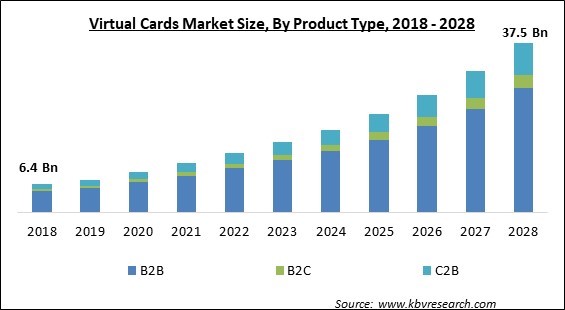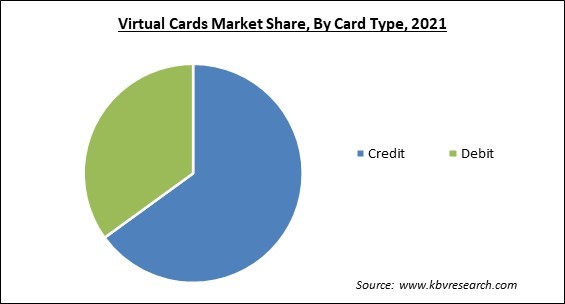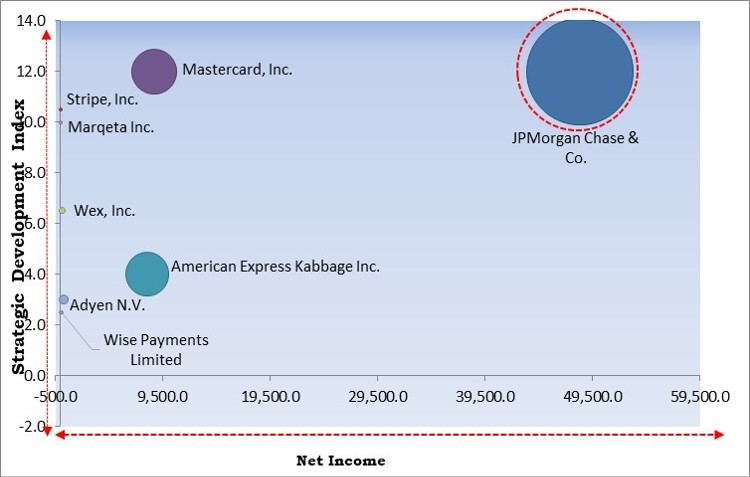
The Global Virtual Cards Market size is expected to reach $37.5 billion by 2028, rising at a market growth of 19.1% CAGR during the forecast period.
For use with mobile ordering and electronic transactions, a virtual card is a type of digital payment system that serves as a token. A process known as tokenization creates credentials automatically, and cards have built-in financial restrictions to finance them for either single-use or multipurpose transactions. A virtual card enables secure online transactions because it lowers the possibility of disclosing to the merchant the actual credit/debit card information. There is very little likelihood of cloning or fraud because they are only visible to the user.

Additionally, each virtual card is only intended for one use. It is made specifically for a single online transaction and is only good for 48 hours. Depending on the bank, the credit validity and limit term may change. By entering one's debit or credit card information online through the bank's net banking service, a virtual credit card can be generated. There are no fees associated with this process and service. They need not be issued physically by card issuers, as the name implies.
Since there are typically far fewer fees necessary for customers of virtual banks, virtual cards are less expensive than real cards. Additionally, since everything is managed online, the virtual bank may lower operating expenses, which allows them to lower the fees for the virtual cards they issue to their clients. In addition, compared to actual cards, virtual cards give their users additional security advantages. Additionally, users can customize their own spending caps on a virtual card, which enables them to increase their savings.
These are thus a few of the driving forces behind the expansion of the virtual cards business. If the smartphone is taken, there is a potential that the user's virtual card, which has access to the virtual card, can be used fraudulently. Furthermore, customer preferences for touchless transactions over traditional payments and the rapid advancement of payment technology are predicted to lead to lucrative market expansion for virtual cards in the coming years.
The COVID-19 pandemic significantly contributed to the market's expansion. After the pandemic, there has been an increase in the demand for contactless payment methods, which is opening up new prospects for the market for virtual cards. The risk of a virtual card potentially spreading illnesses is eliminated because it is not a tangible item. Therefore, the COVID-19 pandemic steadily hampered the growth of the virtual cards market during the initial period of the pandemic. However, the growth of the market expedited exponentially during the pandemic.
The digital revolution has increased access to and utilization of financial services all over the world, changing how people send and receive payments, borrow money, and save money. According to the World Bank, from 68% in 2017 and 51% in 2011, 76% of adults across the world now have an account with a bank, another financial institution, or a mobile money provider. It's significant that the expansion of account ownership was evenly divided among many more nations. The increase in the trend of digital or online payments is one of the major factors that is propelling the growth of the virtual card market.
More quickly than any other innovation in human history, digital technologies have transformed civilizations and have now reached almost 50% of the population in developing countries. Technology may be a huge equalizer by improving connection, financial inclusion, access to commerce, and public services. AI-enabled frontier technologies, for instance, are assisting in the diagnosis and treatment of diseases as well as the extension of life span in the healthcare industry. Distance learning and virtual learning settings have allowed students who would otherwise be cut off from programs to participate. As the foothold of digitalization strengthens all over the world, the adoption of virtual cards would also propel. Hence, this factor is accelerating the growth of the virtual card market.
For card-not-present purchases, such as when customers shop online, virtual credit cards are made. Returning an item to the vendor may be challenging depending on the service they use. The majority of retailers prefer to pay customers back using the same card number that has been used to complete the transaction. An alternative to a refund can be store credit. When users employ a virtual card number to hold a reservation, things can get complicated. The rental business would aim to match the account number that is used to make the reservation with the credit card that is being used for payment in real-time when the customer makes a reservation for a rental automobile. Therefore, these challenges are majorly hampering the growth of the virtual card market.
Based on Card Type, the Virtual Cards Market is bifurcated into Credit Card and Debit Card. In 2021, the debit card segment garnered a significant revenue share of the virtual cards market. Growing net banking usage around the world is anticipated to fuel the demand for virtual debit cards, which would drive the segment's growth. For instance, Google announced the creation of two new payment efforts in May 2022, including virtual cards and digital wallets. This initiative aims to provide people all over the world with improved security and convenience.

By the Product Type, the Virtual Cards Market is segmented into B2B Virtual Cards, B2C Remote Payment Virtual Cards, and C2B POS Virtual Cards. In 2021, the B2B virtual cards segment witnessed the highest revenue share of the virtual cards market. The demand for B2B payments and transactions between businesses has risen as a result of the growing export and import of products and services across the world, which is anticipated to drive the demand for B2B virtual cards.
On the basis of Application, the Virtual Cards Market is divided into Business Use and Consumer Use. In 2021, the business use segment procured the biggest revenue share of the virtual cards market. Virtual cards are used by businesses to make online payments to suppliers and merchants. Because they cannot be lost or stolen, unlike conventional credit and debit cards, these cards offer improved safety.
| Report Attribute | Details |
|---|---|
| Market size value in 2021 | USD 10.9 Billion |
| Market size forecast in 2028 | USD 37.5 Billion |
| Base Year | 2021 |
| Historical Period | 2018 to 2020 |
| Forecast Period | 2022 to 2028 |
| Revenue Growth Rate | CAGR of 19.1% from 2022 to 2028 |
| Number of Pages | 187 |
| Number of Tables | 334 |
| Report coverage | Market Trends, Revenue Estimation and Forecast, Segmentation Analysis, Regional and Country Breakdown, Competitive Landscape, Companies Strategic Developments, Company Profiling |
| Segments covered | Product Type, Card Type, Application, Region |
| Country scope | US, Canada, Mexico, Germany, UK, France, Russia, Spain, Italy, China, Japan, India, South Korea, Singapore, Malaysia, Brazil, Argentina, UAE, Saudi Arabia, South Africa, Nigeria |
| Growth Drivers |
|
| Restraints |
|
Region-Wise, the Virtual Cards Market is analyzed across North America, Europe, Asia-Pacific, and LAMEA. In 2021, Europe accounted for the largest revenue share of the virtual cards market. The UK, Germany, and other European nations with a rising inclination for cashless transactions are projected to fuel the expansion of the regional industry. Additionally, a number of market players are introducing cutting-edge solutions in the European market to entice consumers to adopt virtual cards. For instance, Stripe introduced Stripe Issuing in European countries
Free Valuable Insights: Global Virtual Cards Market size to reach USD 37.5 Billion by 2028

The major strategies followed by the market participants are Partnerships. Based on the Analysis presented in the Cardinal matrix; JPMorgan Chase & Co. is the major forerunner in the Virtual Cards Market. Companies such as American Express Kabbage Inc., Mastercard, Inc., Marqeta Inc. are some of the key innovators in Virtual Cards Market.
The market research report covers the analysis of key stake holders of the market. Key companies profiled in the report include Mastercard, Inc., American Express Kabbage Inc., JPMorgan Chase & Co., Stripe, Inc., Adyen N.V., BTRS Holdings Inc., Wise Payments Limited, Marqeta Inc., Skrill USA, Inc., and Wex, Inc.
By Product Type
By Card Type
By Application
By Geography
The global Virtual Cards Market size is expected to reach $37.5 billion by 2028.
Rising trend of online payments all over the world are driving the market in coming years, however, Lack of knowledge and awareness about virtual cards restraints the growth of the market.
Mastercard, Inc., American Express Kabbage Inc., JPMorgan Chase & Co., Stripe, Inc., Adyen N.V., BTRS Holdings Inc., Wise Payments Limited, Marqeta Inc., Skrill USA, Inc., and Wex, Inc.
The Credit market has acquired the maximum revenue share in the Global Virtual Cards Market by Card Type in 2021; thereby, achieving a market value of $23.75 billion by 2028.
The B2C market has shown the high growth rate of 21.4% during (2022 - 2028). These cards are provided by banks to their retail customers, assisting them in making efficient online payments.
The Europe market dominated the Global Virtual Cards Market by Region in 2021, thereby, achieving a market value of $13.7 billion by 2028.
Our team of dedicated experts can provide you with attractive expansion opportunities for your business.
